“While genius is a rare gift, according to most theorists the pool of human beings from which genius emerges includes only men. Rousseau, Kant, and Schopenhauer all declared that women possess characters and mentalities too weak to produce genius. This judgment represents a particular instance of more general theories that attribute to males the strongest and most important qualities of mind, in comparison to which females are but paler counterparts. At least since Aristotle, rationality and strong intellect have been regarded as “masculine” traits that women possess in lesser degrees than males.”

"Producers of The Naked Feminist needed a poster and postcard campaign for a documentary about feminism in the porn industry in the 1980s. I combined imagery from the film with popular iconographic Barbara Kreuger-esque aesthetics of the time to illustrate the playful, yet radical feel of the film."
Females are standardly considered less intellectual but more sensitive and emotional. According to some theories of creativity, emotionality and sensitivity can be inspirational virtues, and so the field of aesthetics has been more responsive to the positive uses to which these traits might be put than are some other areas of philosophy. When it comes to genius, however, male artists get the best of both worlds: the great artistic genius is more than intellectually brilliant; he is also emotionally sensitive and fine-tuned, thus possessing characteristics that are traditionally labeled both “masculine” and “feminine.”

This morning, I spent so much time on the Sociological Images: Seeing Is Believing blog, that I am out of time. Try it; I think you’ll like it. I check it periodically and always find it interesting. Below is the photo from one of their postings, called Feminist Graffiti from the ’70s ...
…The first feminist. In 1792 Mary Wollstonecraft wrote a book to prove that her sex was as intelligent as the other; thus did feminism come into the world. …
The first person, male or female, to speak at any length and to any effect about woman’s rights was mary Wollstonecraft. In 1792, when her “Vindication of the Rights of Woman appeared, Mary was a beautiful spinster of thirty-three who had made a successful career for herself in the publishing world of London. This accomplishment was rare enough for a woman in that day. Her manifesto, at once impassioned and learned, was an achievement of real originality. The book electrified the reading public and made Mary famous. The core of its argument is simple: “I wish to see women neither heroines or brutes; but reasonable creatures,” Mary wrote. This ancestress of the Women’s Liberation Movement did not demand day-care centers or an end to woman,s traditional role of wife and mother, nor did she call anyone a chauvinist pig.
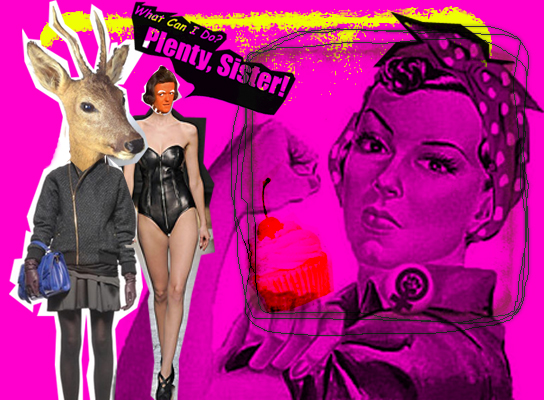
Two twenty-something university students were sitting discussing the specimens on offer in OK Magazine. Their hair was ironed to within an inch of its life. Foundation was caked on in cement style proportions. UGGs were donned, jeggings were worn. I have no issue with these superficial details but I do take umbrage with their conversation, which continued in such a manner for 3 hours. Every aspect of it revolved around the trivialities of what, by some, is perceived to be feminine; fake tan, make-up, waxing, Cheryl’s hair, I could go on and on….but I wish not to relive the torturous banter suffered by my fair ears. I so happened to be reading an article on Sexism in last month’s Elle at the same time spurring me on to debate, who is today’s feminist? Most teenagers I know idolise Cheryl Cole to an unhealthy extreme. She has finally taken action and left her adulterous husband; could this be seen as a positive step for feminism? None of us actually know the truth of their relationship woes, therefore can we judge anything about the soon to be former Mrs. Cole? If you read the Daily Mail, 90% (their favourite statistic) of teenage girls aspire only to be a WAG. I know many who perceive this a positive element of feminism in the new decade as these women are finally taking control and going after exactly what they want. Fashion is an industry in which many strong women reign supreme, but would they earn the same level of respect in any other industry? Are they where they are because of their inherent male traits that they overtly demonstrate to emphasise their power?
The happiest period of Mary’s own life was when she was married and awaiting the birth of her second child. And the greatest delight she ever knew was in her first child, an illegitimate daughter. Mary’s feminism may not appear today to be the hard-core radical variety, but she did live for a time, a scandalous and unconventional life; “emancipated” as it is politely termed by those who have never tried it. The essence of her thought, however, is simply that a woman’s mind is as good as a man’s.
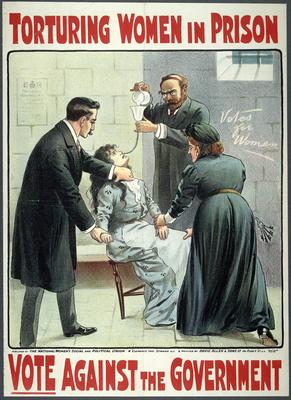
The basis of feminist ideology is that society is organised into a patriarchal system in which men are privileged over women. Modern feminist theory is predominantly, but not exclusively, associated with western middle class academia.
In Mary’s time, to speak of anybody’s rights, let alone women’s rights, was a radical act. In England, as in other nations, “rights” were an entity belonging to the government. The common run of mankind had little access to what we now call “human rights”. as an example of British justice in the late eighteenth century, the law cited two hundred different capital crimes, among them shoplifting. An accused man was not entitled to counsel. A child could be tried and hanged as soon as an adult. The right to vote existed, certainly, but because of unjust apportionment, it had come to mean little. In the land of Washington and Jefferson,as in the land of George III, human rights were a new idea and woman’s rights were not even an issue.
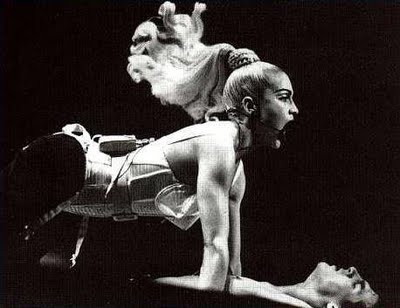
"In short, a Madonna-feminist could be someone who is so sure of her own femininity that she isn’t afraid to play with her masculinity – or others femininity for that matter. She challenges the term by overexposing it, concealing it completely or blending the sexes with each other. However, no matter how she chooses to challenge femininity, it is always about representing the woman as a strong object. A Madonna-feminist can wear everything from a black and white suit to a tight, laced corset, be tied to the bed or the one holding the whip – it do
��t matter, she is someone who claims her role, not as a gender, but as a woman. "In France, in 1792, a Revolution in the name of equality was in full course, and women’s rights had at least been alluded to. The Revolutionary government drew up plans for female education: to the age of eight. Jean Jacques Rousseau from “Emile”:
“Once it is demonstrated that man and woman are not, and should not be constituted the same, either in character or in temperament, it follows that they should not have the same education. In following the directions of nature they must act together but they should not do the same things; their duties have a common end, but the duties themselves are different and consequently also the tastes that direct them. After having tried to form the natural man, let us also see, in order not to leave our work incomplete, how the woman is to be formed who suits this man….Thus the whole education of women ought to be relative to men. To please them, to be useful to them, to make themselves loved and honored by them, to educate them when young, to care for them when grown, to council them, to console them, and to make life agreeable and sweet to them—these are the duties of women at all times, and should be taught them from their infancy. Unless we are guided by this principle we shall miss our aim, and all the precepts we give them will accomplish nothing either for their happiness or for our own.”
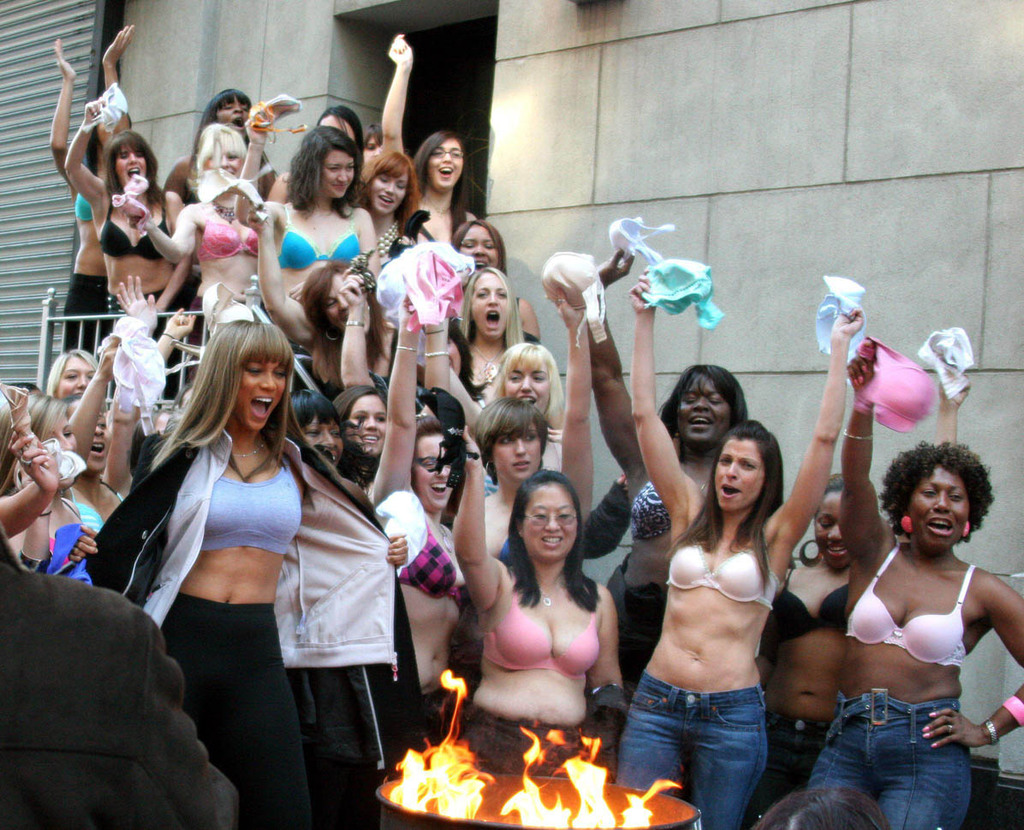
" What do people mean by this? Are people clarifying the fact that they believe in feminist ideals but not in labels? Are people saying that they agree with some feminist theories but not with others? Maybe some of you are probably thinking about bra burning and other popular images of feminism (and yes that is Tyra Banks…wait is she more of a feminist than you are?)…"
Rousseau would have found little cause for complaint in eighteenth-century England.An Englishwoman had almost the same civil status as an American slave. Thomas hardy, a hundred years hence, was to base a novel on the idea of a man casually selling his wife and daughter at public auction. Obviously, this was not a common occurrence, but neither is it wholly implausible. In 1792, and later, a woman could not own property, nor keep any earned wages. All that she possessed belonged to her husband. She could not divorce him, but he could divorce her and taker her children. There was no law to say she could not grow up illiterate or be beaten every day. Such was the legal and moral climate in which Mary Wollstonecraft lived.

Martha Rosler. Semiotics of the Kitchen. "Another example is Martha Rosler demonstrating the function of a juicer as if she were wringing someone’s neck:Rosler’s slashing gesture as she forms the letters of the alphabet in the air with a knife and fork, is a rebel gesture, punching through the “system of harnessed subjectivity” from the inside out.”I was concerned with something like the notion of Ôlanguage speaking the subject,’ and with the transformation of the woman herself into a sign in a system of signs that represent a system of food production, a system of harnessed subjectivity.”( Martha Rosler )
Feminists, and mary would gladly have claimed the title, inevitably get bad notices. The image of the joyless, relentless battle-axe with the suspicion of deformed sexuality hanging miasmally over the tableau. Yet Mary conformed very little to the hateful stereotype. Her life as feminist is the equivalent in trials and tribulations to that of Dicken’s Oliver Twist. Her late twenties were filled with Gothic gloom; her letters to Joseph Johnson so stained with tears, that one cannot help but laugh at the doleful personna of the martyred set-upon elder sister,” I entered the great gates with the same kind of feeling I should have if I was going to the Bastille.”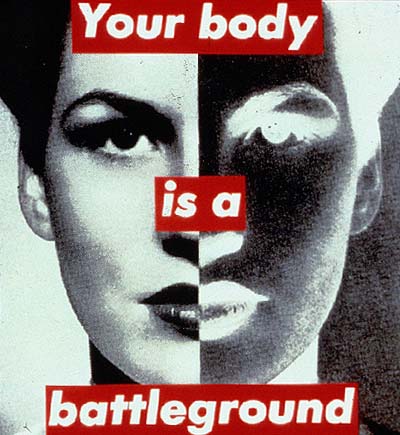
…Feminist perspectives in aesthetics first arose in the 1970s from a combination of political activism in the contemporary art world and critiques of the historical traditions of philosophy and of the arts. They have developed in conjunction with the postmodern debates about culture and society that take place in many fields in the social sciences and humanities. These debates often begin with an assessment of the western philosophical legacy, a legacy that is nowhere more challenged than in the art world itself. Therefore, the significance of many contemporary art movements, including feminist and postfeminist work, is dramatized and clarified by understanding the traditional values and theories that they address and challenge.

"Sarah Lucas’ work operates with a casual post-feminism that contrasts with the more ardent womens’ art of the 1970s or even the theoretical rigor of the 1980s epitomized by Barbara Kruger. Lucas’ work is political in the sense that she espouses a British working class aesthetic. Indeed the YBA (Young British Artist) phenomenon in general took up what might be called ‘tabloid culture’ with something akin to affection. The YBA phenomenon was born in the watershed between the decline of the Conservative Party and the first stirrings of the New (conservative) Labor Party which was to become the darling of the tabloid press they so skillfully cultivated. Sarah Lucas’ work is a quintessentially British in its disrespectful approach to both politics and culture and its fondness for decrepitude and imperfection."
The richest historical target for feminist critiques of philosophies of art has been directed at the concept of fine art, which refers to art that is created chiefly for aesthetic enjoyment. It includes at its core painting, music, literature, and sculpture, and it excludes crafts, popular art, and entertainment. Closely related to the concept of fine art are ideas about the creative genius of the artist, who is often conceived as possessing a unique vision expressed in art works. It was the fine art tradition of painting that art historian Linda Nochlin had in mind in 1971 when she asked her famous question, “Why have there been no great women artists?” .
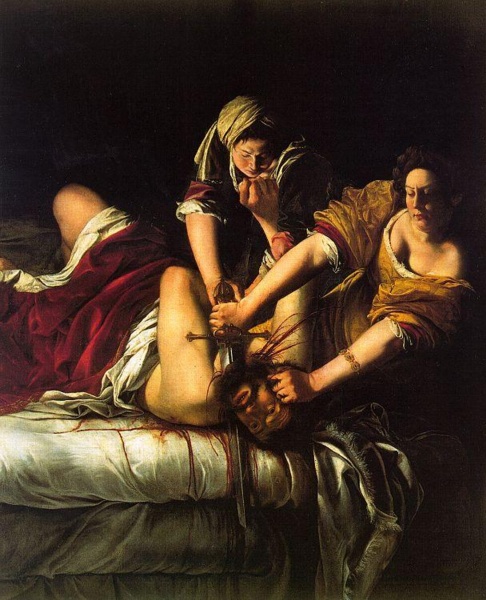
Artemisia Gentileschi. Judith Beheading Holoferne. "Although feminist artists have shown great interest in the depiction of nude figures (both male and female), few feminist artists have shown interest in creating erotic work. Nancy Burns, professor of political science at U of Michigan, differs with this assertion. She points to, "Carolee Schneeman fuses project. Tee Corrinne photography, Katie Niles - Jill Posener - Emma Bee Bernstein - I could go on...." (From a November 28, 2008 email message Burns sent to the author.) Burns takes further exception to the construction of this page: "It's really a problem to set up a list of artists that are 'feminist' when the only thing all of them share is a vagina - these kind of assumptions of lumping women together simply because they're women is everything that's wrong with feminist thinking today."
Christine Battersby has detailed the long and complicated history of the concept of genius, which has roots in antiquity (Battersby 1989). By the time it reaches its powerful Romantic form in the eighteenth and nineteenth centuries, it is especially exclusionary of women artists. The artistic genius was praised not only for the strong mentality that has always been attributed more heavily to men than to women, but also for a sensitivity and creativity that partakes equally of supposedly feminine attributes. Especially in the nineteenth century, such “nonrational” sources of inspiration were extolled for transcending the rules of reason and bringing something new into being. Womanly metaphors of conception, gestation, labor, and birth were liberally appropriated in descriptions of artistic creativity, at the same time that actual women artists were passed over as representatives of the highest aesthetic production.
a





 COMMENTS
COMMENTS
I only remember the word/attitude “feminism” when someone tries to discriminate me/another woman because of my gender; I have never belonged to any feminist group and dislike many things about women in those groups; I read “The second sex” by Simone de Beauvoir when I had already experienced that truth thousand of times in my life, since I was the older sibling of 4, 3 boys the others, who enjoyed a freedom I was very far from having; motherhood is the main reason women do not have as much achievements as men, I guess; to be a mother and a grandma has taken almost all my energies and time in my life; it has given me wonderful moments, though, but not much time left for pursuing intellectual interests, which I have; many people, either men or women, lack that kind of interests, and that is the main point: education should take care that people can fulfill their inherent gifts, skills, talents, intelligence, and in the case of women should be explained to girls what it takes to be a good mother, so she can choose between work and children; I was a very young mother (21), my daughters about 25, now I would like my granddaughters wait until 30, to be able to really choose what they want.